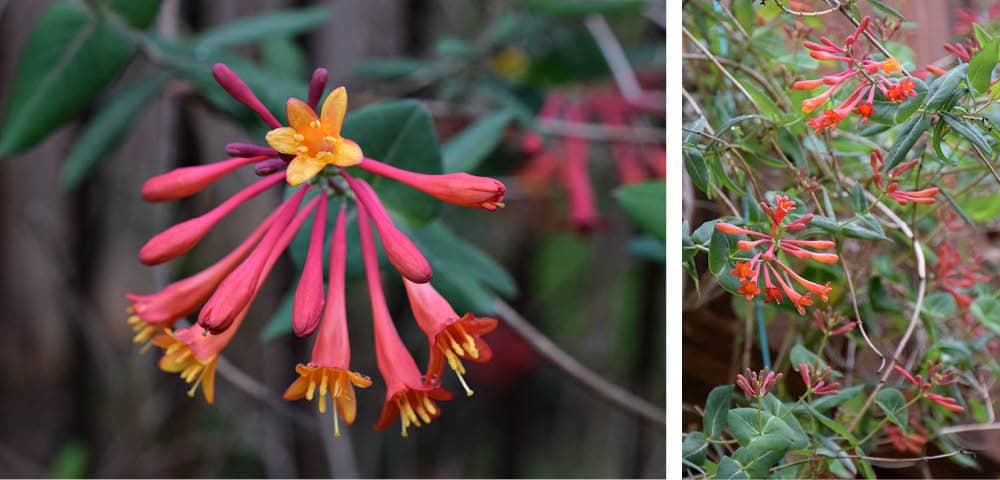2019 Plant of the Year: Coral Honeysuckle
The Georgia Native Plant Society is pleased to announce that coral honeysuckle (Lonicera sempervirens) has been selected as Plant of the Year for 2019. This year marks the program’s twentieth anniversary. Previous selections have included one fern, six trees, five shrubs, and seven herbaceous perennials. Now, for the first time, a vine is getting its day in the sun.
Coral honeysuckle, also known as trumpet honeysuckle or woodbine, is a woody vine that grows naturally along roadsides, forest margins, and in open spaces within the woodland understory. It typically creeps along the ground and twines counterclockwise, weaving its way up and over small shrubs, fences, and trellises, as well as old-fashioned metal mailbox posts; hence the nickname, “mailbox vine.” Unlike the ubiquitously invasive Japanese honeysuckle (L. japonica), coral honeysuckle is not a tree climber; its stems can’t twine around large trunks. It also tends to be shorter, generally reaching a maximum length of about 20 ft.
At maturity, the leaves are 1-3 inches long, elliptical or ovoid, and blue-green, with pale undersides and smooth edges that may curl under slightly. The leaves stay green well into the fall, which may explain the Latin misnomer “sempervirens,” meaning evergreen, although the plant is actually deciduous. New spring foliage has a purplish tinge, with a pronounced under-curl at the leaf margins, making the plant easy to distinguish from other vines. Leaves are opposite and distinct, except for the terminal pair, which is fused.
In April, when the leaves are still immature, a short stem, topped by a cluster of six pinkish flower buds at a single node, can form to perfuse the terminal leaf pair. As the stem grows, the buds elongate into six closed tubes, each formed from five united petals, which stick out like spokes from the stem. When they reach 1.5-2 inches long, the tubes open, to stunning effect. Each tubular blossom is vivid scarlet on the outside, with a small, bright green calyx at its base. The inner throat flares out, terminating in five lobes. Five stamens and pistils protrude beyond the flower’s throat. Anthers at the tips of the stamens are covered in pollen, while the pistils have flat discs at the ends. All of the inner parts, even the pollen, are a bright golden yellow.
Flower stems continue to elongate throughout the spring and into summer, forming additional nodes and flower clusters, with the most mature blooms found closest to the leaves. A stem can sometimes twist as it grows, making the inflorescence look whorled. As the flowers mature and fall off, berries appear, ripening from green to yellow to red. Meanwhile, the plant continues to produce new growth. Throughout late spring and early summer, an individual vine might produce berries, new leaves, and flowers, all at the same time.
Coral honeysuckle’s flowers are a rich source of nectar. Hummingbirds — particularly ruby-throated hummingbirds — love to feed on them and are key pollinators. The flowers are also visited by moths, butterflies, and some bumblebees, but not honeybees. Several caterpillar species feed on the vine’s leaves, including the Spring Azure butterfly, the Snowberry Clearwing moth, and the Hummingbird Clearwing moth. Birds are also attracted to the plant, feeding on its berries.
For the most part, people use coral honeysuckle primarily as an ornamental plant. There is not a strong tradition of nutritional or medicinal use, and the species is absent from the current herbal pharmacopeia. Native Americans once used indigenous honeysuckles in remedies for coughs and lung ailments. Coral honeysuckle was likely used in this manner; however, it is difficult to say for sure because the plant’s old colloquial name “woodbine” also refers to other native honeysuckle species (as well as Virginia creeper). Honeysuckles were also used to treat bee stings [1].
Europeans first identified coral honeysuckle during the early colonial period. John Tradescant the Younger, gardener to King Charles I, introduced the plant to England from Virginia in the 1600s [2]. William Bartram, the first American artist-naturalist — famous for exploring north Georgia along what we now know as the Bartram Trail — was familiar with the species. A coral honeysuckle flower graces the top corner of one of his drawings. It can be seen in collection of his works from 1756-1788 [3].
Coral honeysuckle is a wonderful garden plant. It can be propagated from either seeds or cuttings. Put it in decent soil — it won’t do well in clay, give it a trellis or other support for climbing, and water until it is established. After that, it is fairly low maintenance. To encourage flowering, plant it where it gets plenty of sunlight, don’t over-fertilize, and prune immediately after flowering to encourage re-growth — it blooms on new wood. The result can be outstanding. A mature coral honeysuckle in full flower is a sight to behold.
- J. K. Crellin, Jane Philpott, A. L. Tommie Bass (1990) Herbal Medicine Past and Present: A reference guide to medicinal plants. Duke University Press. Durham and London. pp. 246-7.
- Kew Science online powo.science.kew.org/taxon/urn:lsid:ipni.org:names:30080890-2
- W. Bartram (1968) Botanical and zoological drawings, 1756-1788: reproduced from the Fothergill album in the British Museum (Natural History). Memoirs of the American Philosophical Society. Philadelphia. Vol 74, p. 247.

